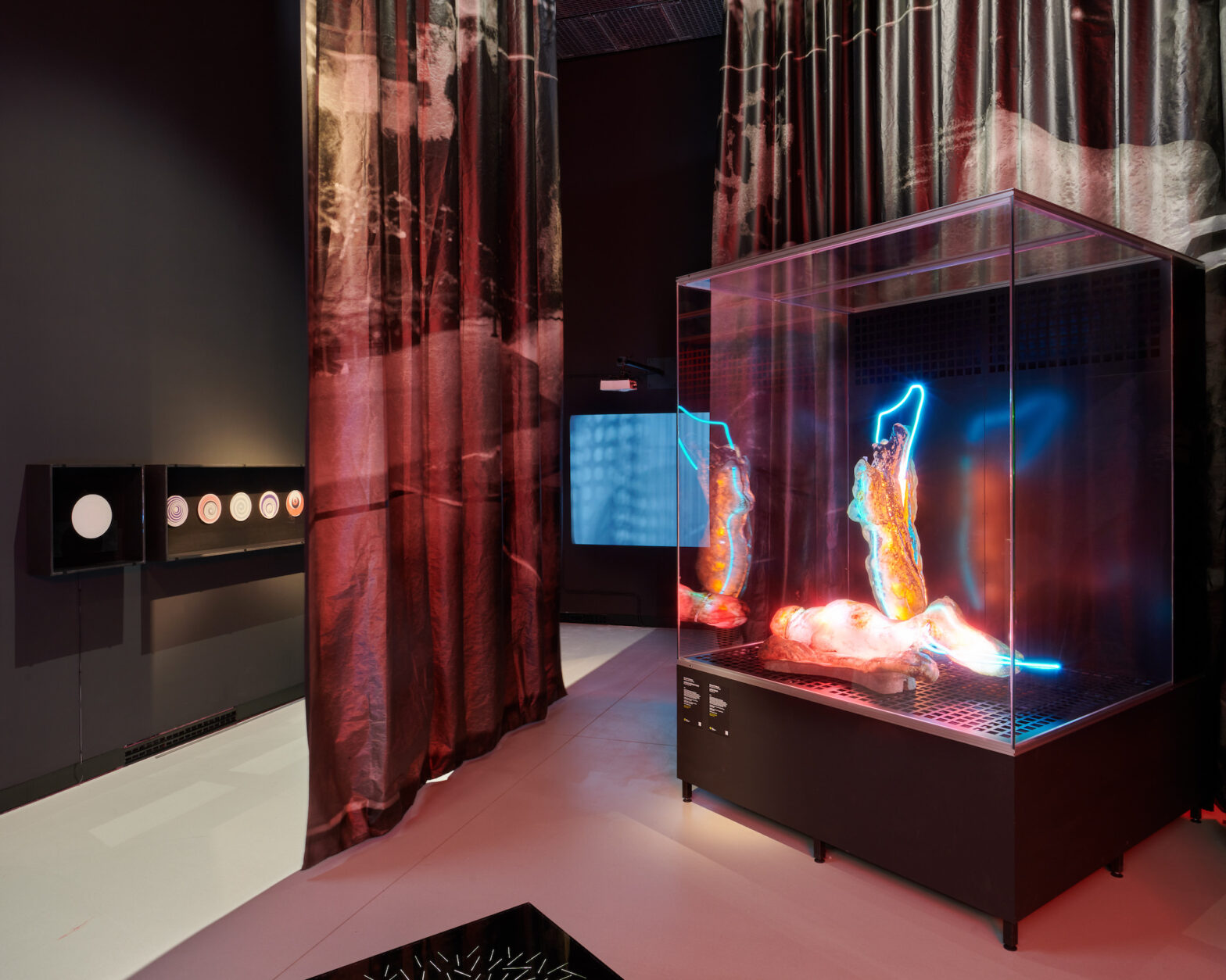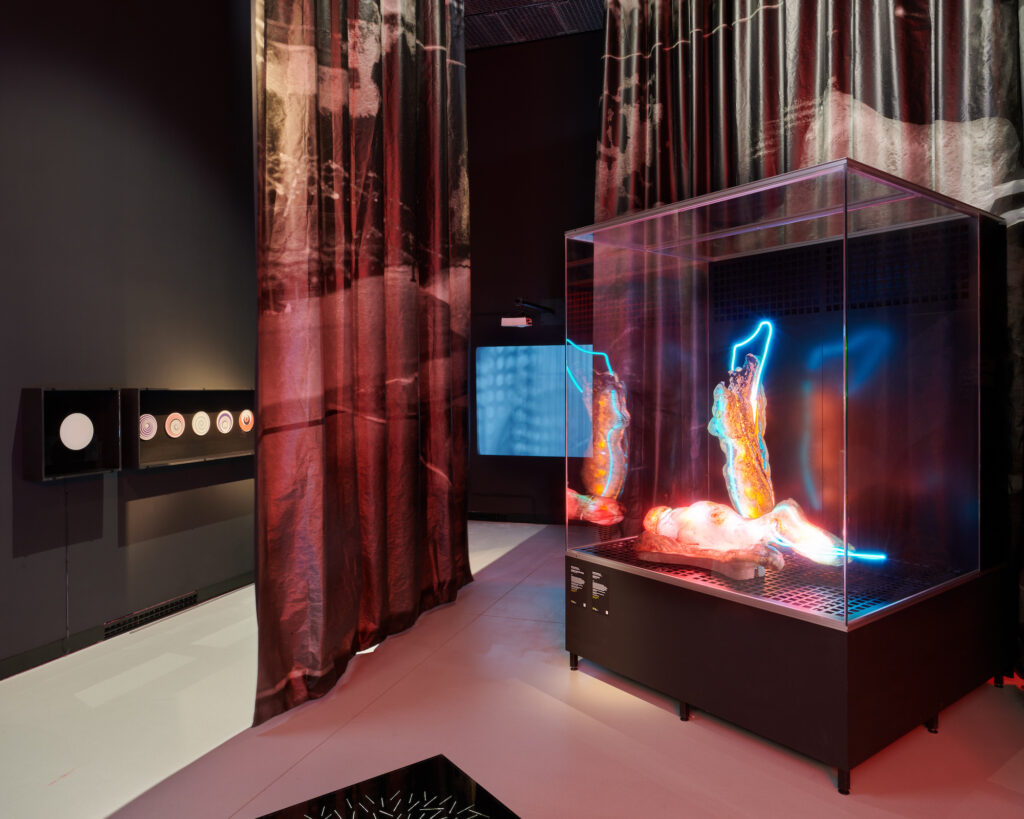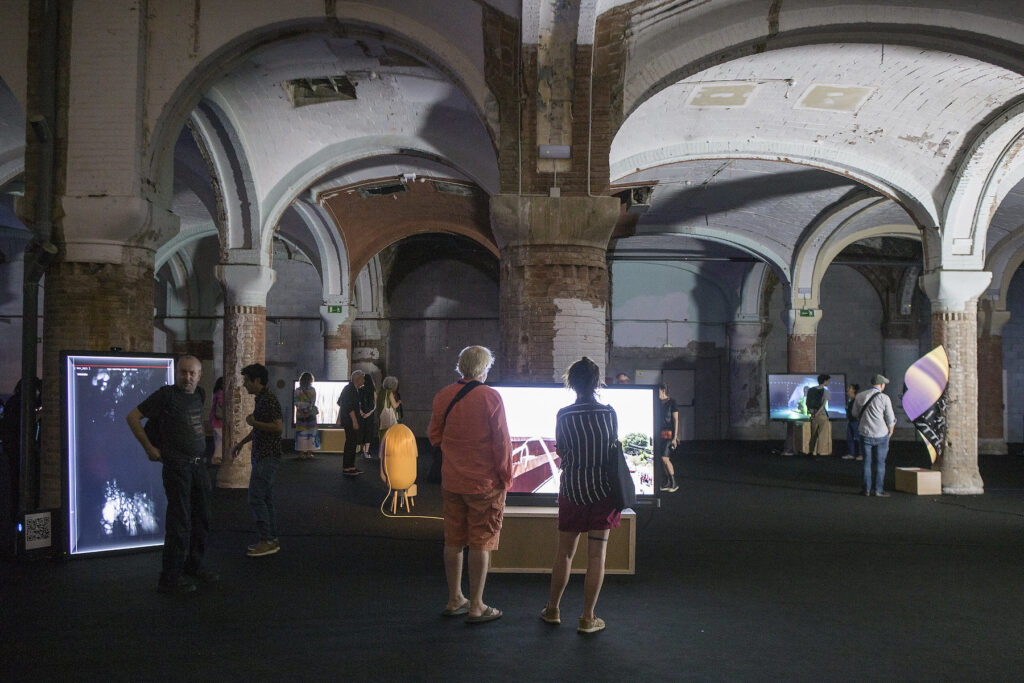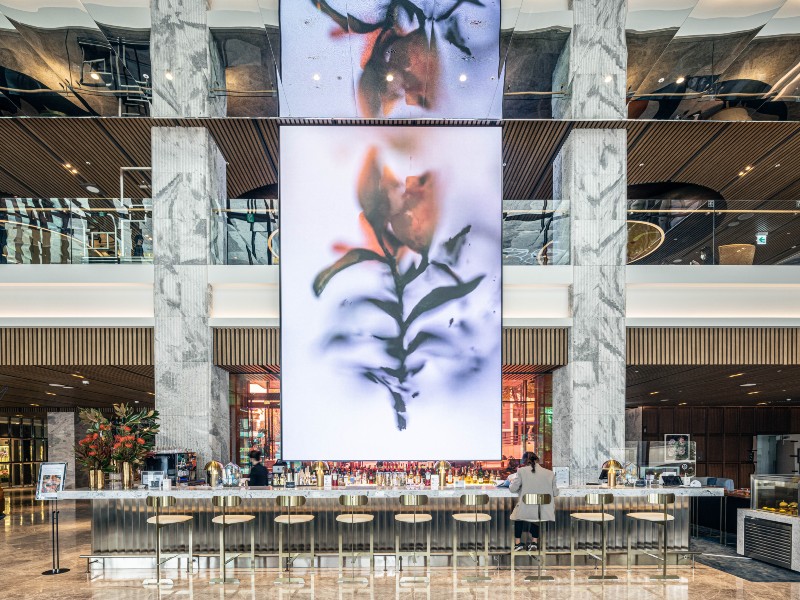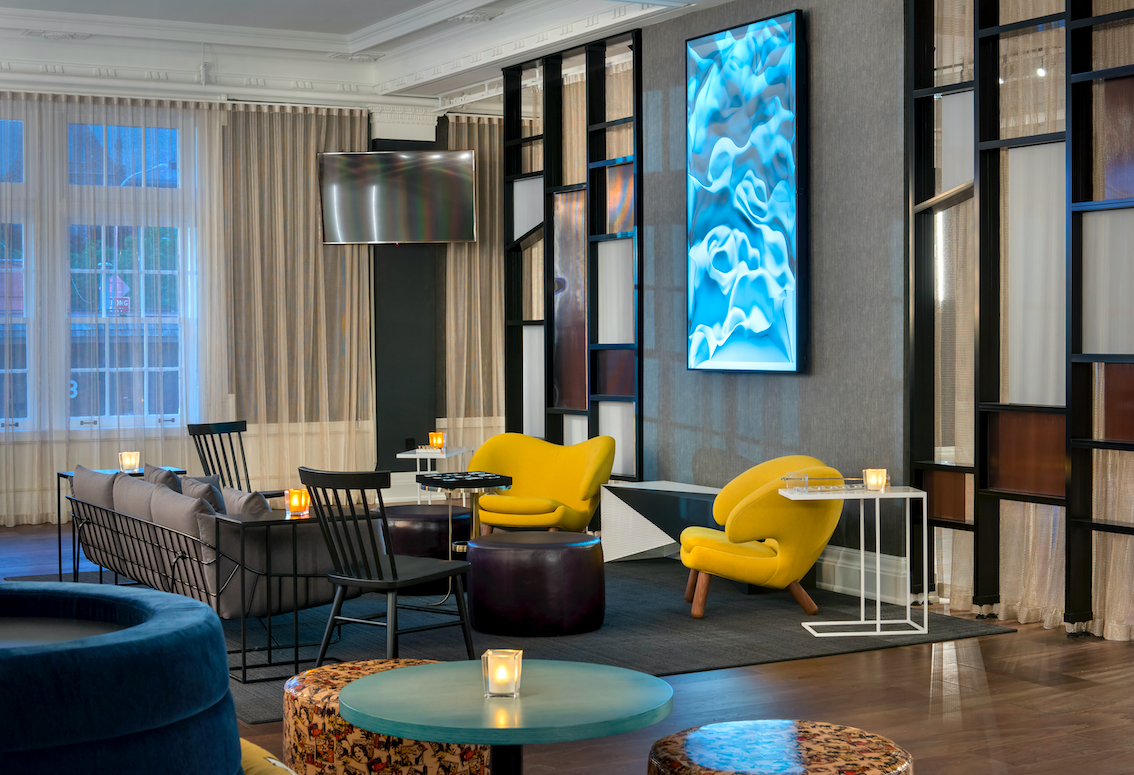Pau Waelder

Artist and researcher Aaron M. Higgins holds BFA and MFA degrees from The Henry Radford Hope School of Fine Art at Indiana University. Higgins delves into time-based media as an artistic medium, employing lens-oriented capture methods, digital layering processes, and interactivity. His artwork has been showcased both within the U.S., including cities like Chicago, Cincinnati, and New York, and abroad, with features in Korea, Sweden, and the Netherlands among others.
Higgins recently presented the solo artcast Memory Palaces on Niio, featuring a series of artworks in which the artist draws inspiration from microscopic images of the human brain, as well as those taken by the Hubble Space Telescope, to create alluring, surreal landscapes. In the following conversation, he reflects on the relationship between his digital media work and his background in painting, as well as his connection to landscape and nature.
Bring Aaron Higgins’ mnemonic landscapes to your screen
Aaron Higgins. Memoria, 2017
You have a background in painting prior to your digital media practice. How did you move from one medium to the other, and how does your knowledge about painting inform your digital work, which is at times deliberately painterly?
My undergraduate studies were in Painting, and my graduate studies focused on Digital Media. I found working with Digital Media somewhat intuitive and picked things up relatively quickly. I think my strengths lie in how I compose and composite imagery in my work. A lot of this is similar to how I think about composing a 2D rectangle, but with time-based media I am also considering how the composition moves and changes over its timeline. As with a drawing or painting, I consider how the eye might move around the image, or how space is constructed within the composition of the image. I also want something for the eye to sense, or feel, as it relates to the surface, so I think a lot about visual texture, and compositing methods that yield a ‘painterly’ quality. I guess in some ways I am trying to work against the sanitization of the screen-based image. In the same vein, I am also subverting the ‘digital’, or ‘machine’, and attempting to reimplement ‘the hand’.
“In some ways I am trying to work against the sanitization of the screen-based image and attempting to reimplement ‘the hand’.”
There is an interest in landscape in your work, from the documentary-style images of Tallgrass to the surreal environments of Mnemonic Passages. What do you find in landscapes that is interesting for your work?
The landscape has it all. I try to maintain a connection to the landscape, in my life and in my work, although it’s not necessarily front of mind. Most of my earlier work, painting, focused on painting in the landscape, as well as still-life, which I also think of as landscape. I’ve always been fascinated by nature, after all, we emerged from mother nature. To me, there is something spiritual in connecting with and observing nature, of being immersed in the landscape. The landscape can be so many things, a prairie, a memory, a body, a mind, etc. In my early interactive works, the Splitting Time series, I suppose that I am thinking of time, and the image itself (what the camera sees), as a landscape and reorganizing its pieces into abstract compositions. In a sense, everything is a landscape of sorts.

Since the landscape is a cultural construct, as Alain Roger has suggested, which roles do fiction and narrative play in your landscapes?
That’s an interesting question. As I mentioned in my previous answer, the landscape holds endless metaphoric possibilities. The landscape often serves as a placeholder for something else. In many ways we project our own values, ideals, and biases on the landscape before us. Artists do the same in their work, and the viewer does the same in experiencing the work. I try to leave room for this to occur. In the Tallgrass series, for example, the work is representative of my experience in the tallgrass prairie landscape. I want to share that dynamic, interactive experience with the viewer. In doing so, however, I am weaving a lot of fiction. The imagery is highly composited, creating something other than reality. Maybe a collage of reality… creating an ideal, but there is also a more universal narrative that is superimposed on the work transcending any information gathering, documentation, or individual experience.
“The landscape often serves as a placeholder for something else. In many ways we project our own values, ideals, and biases on the landscape before us.”

In the Mnemonic Passages series, the imagery is completely invented, but I use actual video in my compositing process. In this series, particularly, I am using webcam footage of myself (working on things in front of my computer) as textures that wrap the 3D forms (memoryforms). This adds the hint of subjective imagery inside, or across the surface of these forms. It also helps to create a sense that these forms are flickering with information. In this way, as with other works of mine, there is an element of self-portraiture to my work as well as landscape.
Regardless, the process usually involves taking photo imagery and creating something ‘new’ with it.
Aaron Higgins. MemoryForm (1), 2017
In the Mnemonic Passages series, you depict memory palaces as organic, and somewhat otherworldly spaces instead of the rational, neo classical buildings we are used to imagine. What drove you to choose this type of image?
With the Mnemonic Passages series, I suppose I am really thinking of the memory palace as the mind. I was thinking of the biology of the brain, the intricate architecture of neurons and synapses, etc. But, also as a place, a landscape, where memories are stored. These memories take form and shape within our minds, building the landscape of our experience. Of course, as I say in my statement, I am inspired by imagery from the scientific research and study of the brain, but also imagery from the research and study of our cosmos. The cosmos might be a ‘superlandscape’, if you will, that I see as a metaphor for our mind, or accumulated experience and knowledge. As our experience and knowledge grows, so does our picture and understanding of our cosmos.
“The cosmos might be a ‘superlandscape’ that I see as a metaphor for our mind, or accumulated experience and knowledge.”

Where does your interest in memory stem from?
I guess my interest in memory stems from ideas related to your previous question. Our memory and experience, our culture (a form of generational memory) forms our identity. Like culture, a memory is a living thing that can change, bits are added, bits are taken out, we fill in missing bits to keep the landscape (trying to be consistent with my metaphors, here) cohesive and making sense. Neuroscience is also very relevant these days with new groundbreaking discoveries in how our minds work seemingly happening all the time. The same could be said about the cosmos and what we are learning from the James Webb Space Telescope. We are literally looking back in time at the earliest galaxies that formed in our universe, amazing stuff.
Aaron Higgins. MemoryForm (2), 2017
You speak of creating meditative experiences through works that you patiently build layer by layer. How important is that meditative aspect in the making of the artwork, as your own experience, and then in the final result, as the experience of the viewer?
I really believe the work and craft that goes into something adds to what is communicated to the viewer and their experience. Craftsmanship is an important part of the process, always. One of things I love about painting is how meditative the act of painting is. There’s a lot that I find similar in my creative process with Digital Media. For one thing, the work evolves over time, and you have to be open to those changes. An idea I start out with is not always the same as what I end up with. I, too, evolve and change throughout the process and find that my interests lead me in new directions. The work sometimes has a will of its own, too, it seems, whether it be the nature of the tools, or limitations of the software or hardware (or myself), it always seems to be a negotiated process. Beyond that, choices are made as things progress that depend on what has happened up until that point, until the work is resolved. I try not to labor too much on these choices and let the work tell me what to do, if that makes any sense, and being in an open, meditative state tends to help with this process. It can be a challenge, though, when your computer crashes, or render times get unbearably slow.

As far as the viewer experience, I guess I am sort of imposing my preferences and communicating what I want my work to be in how I present it. However, I do want the work to be disarming, calming, and perhaps to create a sense of wonder and awe. When I think of my time-based work, I often think of paintings, as we discussed. I think of viewing a painting as something that happens over time. The painting is always on, always there to be received. As it is experienced and one is immersed, the more that is discovered, it changes. The context within which a work is experienced also has an effect on the experience. Is it on a screen, a phone or a television, is it projected? In what space is it, a private or public space? I try to apply these ideas to the presentation and structure of my time-based work. All of my work seamlessly loops and is always on, there is no beginning or end. It is there to be experienced at viewer discretion, for 30 seconds, 10 minutes, or an hour, or more. It’s there when you want it, for as long as you want it. In that sense, I do not want the work to be annoying or overbearing. I want it to be tolerable, I guess, not seizure inducing.
“I want to give viewers the space to experience the work on their own terms, as well as allow space for the viewer to discover new connections with the work the more they experience or interact with it.”
Yet, I also don’t want the viewer to ignore the work, I want them to be engaged. I don’t want to impose too many parameters on the viewer or make it a chore to experience the work. In this sense, I think a lot about control, and the relationship between artist and viewer, viewer and art, etc.
Control then becomes a subject I explore as it relates to life, my experience, the creative process, etc. I try not to exert too much control, especially on things that are out of my control. I know I’m getting in the weeds here… But, I guess, this goes back to the landscape, haha… and the process having its own sort of evolution that involves the artist and the media and letting that process occur without too much interference. I want to afford the viewer the same opportunity in how they experience the work.
To quote Caroline Lavoie, from an article titled, ‘Sketching the Landscape: Exploring a Sense of Place’, “An object or person does not exist in isolation, but through relationships with its context. These relationships support a necessary state of being…”.
Tough question.
Aaron Higgins. Mnemonic Passage, 2017
You have expressed your interest in incorporating the viewer into your work, through interactive installations. How would you compare your interactive work with your films and animations in terms of their concept, production process, expectations, and outcome?
So, I think, picking up where we left off in the last question… I am interested in introducing more randomness and perhaps an element of surprise to my work and how others experience it. Something that is always on, and loops endlessly, runs the risk of becoming monotonous. Adding some randomness and unpredictability can thwart the monotony, and keep viewers engaged. This also speaks to the landscape, self-portrait concepts, as well as the viewer/art/artist relationship, and how things change over time.
In the ‘Tallgrass’ series, for example, the viewer would trigger events in the landscape: lightning striking, the sun setting, moon rising, bird calls, different poses and movements, etc. For each scene, a clip from a library of audio clips with variations of bird calls could randomly be paired with a video sequence of a bird singing. Motion sensing cameras trigger events as viewers move through the space. This adds slight variation and randomness in experiencing the work, so that experiencing the work again would almost certainly be different in variation and sequence of events. To me, this more closely resembles my experience in the tallgrass prairie, where things are the same, but different each time I visit.
“Adding some randomness and unpredictability can thwart the monotony, and keep viewers engaged.”
My life experience, my interrupted or failed plans, my unexpected successes and victories, all the predictable and unpredictable events… This sort of ‘passive interaction’, allowed in ideas of control vs chaos which made the work feel more alive and real to me. Back to the prairie, when I would hike in the prairie and see an animal, they didn’t act as though I wasn’t there, they responded to my presence.
In turn, this extends to the viewer, who in some cases was literally incorporated into the work, i.e. Karmic_Lapse, and altered the work by viewing it. As it relates to the artist/viewer relationship, the work is completed upon experiencing. That is to say, work is meant to be shared with and received by a viewer, an audience. That is when a work comes alive, not in my mind, but the mind of the viewer. We can relate this back to the Lavoie quote, “an object (or person) does not exist in isolation, but through relationships with its context.”

In relation to your code-based work, you speak of a “collaboration” with the software. How do you balance control and randomness in these projects, and what would you say that you have learned from the machine?
I enjoy how these questions are threaded together, these are really good questions. First, I am not much of a coder, but I use After Effects java-based expressions, visual coding languages- connecting inputs to outputs, I used to use actionscript, that sort of thing. To answer your question, though, the machine, its operating system runs on code, the software runs on code, I implement code, etc. It’s all doing things for me, in a sense. I mean, I tell it what to do, but I don’t completely understand how it’s doing it. So, in that way it is a collaboration, I guess. But, as far as balancing control and randomness, there are serendipitous things that occur throughout the creative process. I try to let these things occur, even push the process, the machine, to catalyze their occurrence. These are moments where something unexpected, something random occurs that adds to the piece. There’s a lot of experimentation involved, trial and error, but it’s a sort of dance seeing where things go and knowing when you’ve gone too far. This applies to painting, as well, there are some tools, like the palette knife, that can offer great control, but also, if used in a certain way, can create randomness in the application of paint to the surface. It further removes ‘the hand’, so to speak.
“I guess my background in more traditional media is keeping me grounded, and I am not quite ready to let the machine take over.”

I’m not sure what I’ve learned from the machine. It’s constantly changing. It’s a great tool and allows for infinite possibilities. But it can get old, too… Sometimes I feel that things have been homogenized to a degree, and things all start looking the same. I see a lot of that in AI art, especially. I guess my background in more traditional media is keeping me grounded, somewhat, and I am not quite ready to let the machine take over.


